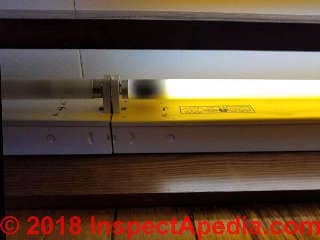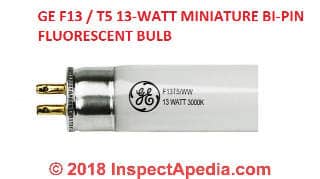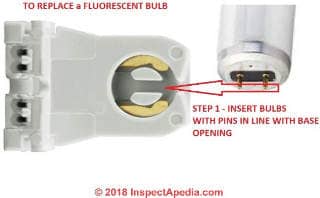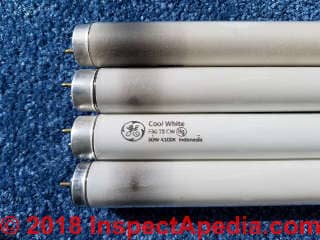 Fluorescent Bulb Troubleshooting
Fluorescent Bulb Troubleshooting
Diagnose & replace fluorescent light bulbs (lamps)
- POST a QUESTION or COMMENT about building electrical systems, power, wiring, and flickering or dimming lights
Steps in diagnosing and repairing a flickering fluorescent light bulb or lamp:
When one or more fluorescent light fixtures are humming or flickering or if the light simply won't turn on, the problem may be something as simple as a bad fluorescent bulb.
Here we suggest the steps to follow to determine if the problem is a loose bulb or lamp, or a defective one that needs to be replaced.
Page top photo: blackening visible at one or both ends of a fluorescent bulb means that the bulb is at or near the end of its life.
This article series explains how to diagnose the causes of flickering, dim, or dead fluorescent lights at or in buildings.
Watch out: flickering or dimming lights might indicate a dangerous condition risking a building fire or an electrical shock. If the simple bulb or starter repairs we describe here don't cure the flickering, switch off the bad-acting light fixture, leave it off, circuit and ask for help from a licensed electrician.
InspectAPedia tolerates no conflicts of interest. We have no relationship with advertisers, products, or services discussed at this website.
- Daniel Friedman, Publisher/Editor/Author - See WHO ARE WE?
Diagnose a Bad Fluorescent Light Bulb
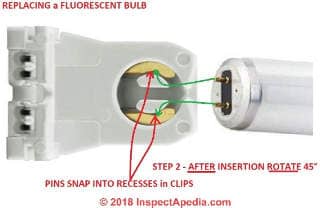 If the light fixture had trouble starting and kept flickering the problem could be a bad connector at one or both ends of the bulb, a loose bulb, or a bad bulb.
If the light fixture had trouble starting and kept flickering the problem could be a bad connector at one or both ends of the bulb, a loose bulb, or a bad bulb.
[Click to enlarge any image]
First check the bulb connections.
Taking care not to break the bulb and blind yourself with mercury1 and glass, gently grasp the fluorescent bulb and try turning it back and forth so that its connector pins scrape and clean their connections in the clips that connect to the bulb ends.
Sometimes I find that the bulb had never been seated properly in the first place, and on occasion I find that the connectors were dirty or arc-burned.
Rarely I find that the connector's internal metal spring clips have broken, or even fallen out of the connector completely so don't forget to try looking at the connector to see that its metal clips are inside.
Details are at FLUORESCENT LAMP CONNECTOR / SOCKET REPLACEMENT.
Below on this page we show how to insert and twist the fluorescent lamp so that it snaps into place.
Next look at the bulb more-closely
If the bulb ends are blackened, even slightly, the bulb may be near the end of its life or even past it.
In my photo above the lit-bulb in this fluorescent fixture is quite black at one end.
Other bulbs, also blackened (shown at page top) refused to light at all. We replaced both the dead bulbs and also the nearly-dead one shown here.
Next try a replacement lamp
Take a bulb from a fixture working properly and test it in the flickering fixture; also look for black or other discoloration in the flickering bulb.
Often a failing fluorescent light bulb will begin to darken or even look black at one or both ends. Eventually the bulb simply won't light.
Replace it.
See REPLACE a FLUORESCENT LAMP / BULB just below on this page for details about how to remove and insert fluorescent lamps.
On a GE F13 / T5 Miniature Bi-Pin like the one shown above, F13 refers to a 13-watt fluorescent bulb, and T5 refers to the bulb shape (straight). This particular bulb is 20.91" long and its bulb diameter is 0.625 inches.
Watch out: handle fluorescent bulbs with care to avoid breaking one.
If you break one of these fluorescent light bulbs - containing mercury - you will release not only a million tiny fine glass fragments but also mercury laden dust that is toxic to breathe or get on your skin.
Get the right fluorescent bulb - or in electric-speak, "lamp" for your light fixture by taking the old one to your electrical or building supplier.
Finding the right bulb is easy if you have the old one, since that makes it easy to match the original by bulb type, size, and wattage.
At FLUORESCENT LIGHT BULB CODES & TYPES we provide a table of fluorescent bulb type and identification codes, and
at FLUORESCENT LIGHT BULB PHOTOS we show you what these look like.
Some LED options and instructions for replacing a fluorescent bulb are
at SOURCES for INSTRUCTIONS, PARTS, REPLACEMENTS for fluorescent bulbs, transformers, parts.
Dispose of the old fluorescent bulb properly
If you replace a fluorescent bulb, consider taking the old bulbs to your vendor for recycling.
In the U.S., accordance with the Resource Conservation & Recovery Act (RCRA), the mercury content in fluorescent lamps (bulbs) manufactured after 1990 was significantly-reduced; before 1990 these bulbs are higher in mercury content.
Manufacturers such as GE labeled the newer low-mercury bulbs with an "Eco" suffix.
Guidelines and regulations about disposing of fluorescent lamps are
at FLUORESCENT LIGHT FIXTURE BULB / BALLAST DISPOSAL
What to check next
If replacement with a known-good lamp doesn't get the light fixture working the problem may be in the starter or in the ballast.
Try Replacing the Starter
The starter is a small canister that simply clips into a socket behind one end of the fluorescent lamp.
Details are at FLUORESCENT LIGHT STARTER REPLACEMENT.
If necessary Replace the Ballast
If the problem is not the bulb, the starter, the connectors or wiring, and especially if the light fixture was humming the problem is probably the ballast.
Details on replacing and wiring a new transformer or ballast are
at FLUORESCENT LIGHT TRANSFORMER / BALLAST REPLACEMENT.
How to Replace the Fluorescent Lamp / Bulb in the Fixture
[Click to enlarge any image]
Watch out: before you call for help because you can't find the starter on your fluorescent light, check the bulb and socket type Bi-pin bulbs and sockets support programmed start bulbs and require a separate starter.
Single center-pin type bulbs and sockets, also called instant-start bulbs, do not use a separate starter device.
Watch out: take care not to break the old or new bulb: you don't want a face of glass shards and toxic mercury. Wear eye protection.
Our photos should make clear what has to happen.
To remove the old bulb, turn it gently about 45 degrees to allow the bulb pins to align with the entry/exit slot in the bulb base and gently wiggle the bulb straight out.
To insert the new bulb reverse the process. Keep the bulb straight in line with the two bulb base sockets as you insert its pins straight into the socket slot, then rotate the bulb 45 degrees to feel it snap into place.
The Leviton 13351 T8 / T12 turn-type lampholder shown in the photos above takes a 1" diameter bulb and is designed for a medium, bi-pin socket, "non-shunted" for programmed-start ballasts.
It is also rated for up to 660 Watts and 600 Volts - which will be far more than any typical residential fluorescent light bulb.
You can Also Replace Traditional Fluorescent Bulbs with LEDs
I've had good success replacing fluorescent bulbs with LED equivalents that use less power and are less annoying with flickering, starters, and transformers.
However some additional skill - or maybe less skill - is required in electrical wiring the replacement LED.
In short, you'll follow steps similar to these:
Watch out: be sure to read and follow the instructions from the LED replacement bulb manufacturer as the details will vary from what we show here.
Watch out: You could be shocked or killed. Turn off electrical power before touching or attempting to work on electrical lights or fixtures.
Watch out: if you are not trained and comfortable with proper electrical wiring and repair work, hire someone who is qualified. Making a mistake can cause a building fire, shock, injury, or death.
Turn all electrical power off
- Remove the fluorescent bulb
- Discharge the transformer by shorting it to ground
- You MIGHT need to remove the transformer (you may need to pay a disposal fee to get rid of the carcass)
- You MIGHT need to re-wire the lamp sockets to the incoming power wiring
- Install the LED bulb
GE's instructions add: Note: In case of fixture supplied with electronic ballast, the green cap of the GE LED T8 Universal tube can face any of the two directions. If tube does not start up properly, then you can try to exchange direction or go to the direct wiring/new luminaire section of the instructions. - source cited in detail below.
See some LED options and instructions for replacing a fluorescent bulb
at SOURCES for INSTRUCTIONS, PARTS, REPLACEMENTS for fluorescent bulbs, transformers, parts
...
Reader Comments, Questions & Answers About The Article Above
Below you will find questions and answers previously posted on this page at its page bottom reader comment box.
Reader Q&A - also see RECOMMENDED ARTICLES & FAQs
On 2021-01-16 by (mod) - The middle two bulbd are lit but the outside two are not.
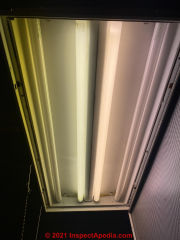 If swapping in a tube that is known to be good doesn't light, look for a bad connector or failed starter or failed ballast.
If swapping in a tube that is known to be good doesn't light, look for a bad connector or failed starter or failed ballast.
Since two bulbs are out I suspect a bad ballast that feeds the outer two bulbs.
On 2021-01-16 by Colin J
I have a 4 tube shop light in my garage. The middle two are lit but the outside two are not. Please advise.
On 2020-10-28 - by (mod) -
Try putting the fluorescent tubes back where they were working previously or install a tube that you know is good back at the previous locations. If they work there that will tell you the problem maybe a different starter or it may be a bad connector for the bulb
On 2020-10-28 by Marilou
I have a 4 tube light fixture that has only 2 tubes that light. Rather than have them next to each other I decided to move to outer edge on either side. The tube I moved works fine and the the next to it has started lighting but now both tubes are out on the other side!!! What's going on with this???
On 2020-10-12 - by (mod) -
Jared
I've run into the bulb failure problem you describe with several electrical products that were, sorry-to-say, simply so poorly made that any twisting or torque applied to the connector end(s) of the bulb cause it to tear apart. At least some of the fault here lies with vendors selling the absolutely-cheapest-possible product, usually made offshore.
On 2020-10-11 by Jared Abbott
Brand new black lights bulb went out, i slightly turned the bulb and it came back on for 5 mins, no flickering, and suddenly died... when i removed the bulb one side of the bulbs bi pins had a tiny wire poking out and fell off leaving 2 tiny pin holes in the end of the bi pins.. not sure what happened or if its the issue tbh
On 2020-08-25 by Lori
My fluorescent bulbs burned out and has a slight glow at one end. This bulb is on a switch with another light fixture and that bulb still works. Is it dangerous to turn on that switch with the burned out fluorescent bulbs still in its fixture?
On 2020-01-12 - by (mod) -
Possibly wrong ballast
and / or poor wiring connections
On 2020-01-12 by janice m martin
We changed the ballast and put in two new bulbs on the 8' fixture, but the bulbs are not bright. One is dimmer than the other and appears to have "pulsing" light flickering through it, the other is static but dim. Any thoughts?
On 2019-01-03 by Jeff
I have 4 , 21 inch under cabinet 13 watt ge fluorescent bulbs and 2 , 12 inch that are no g in a show cabinet for shot glasses how should I wire these and what do I need
...
Continue reading at FLUORESCENT LIGHT BULB CODES & TYPES or select a topic from the closely-related articles below, or see the complete ARTICLE INDEX.
Or see these
Recommended Articles
- DIRECTORY OF ELECTRICIANS
- FLUORESCENT LIGHTING GUIDE INDOORS for Indoors and Guide to Using Compact Fluorescent Lights
- FLUORESCENT LIGHTS COMPACT INDOOR
- FLUORESCENT LIGHT REPAIRS
- HOW FLUORESCENT LIGHTS WORK
- ELECTRIC POWER LOSS / FLICKERING LIGHTS
- DIAGNOSE a BAD FLUORESCENT LAMP / BULB
- REPLACE a BAD FLUORESCENT LAMP / BULB
- FLUORESCENT LIGHT BALLAST TYPES
- FLUORESCENT LIGHT BULB CODES & TYPES
- FLUORESCENT LIGHT BULB PHOTOS
- FLUORESCENT LIGHT BULB COLOR TEMPERATURE
- FLUORESCENT LIGHT FLICKERING CAUSES
- FLUORESCENT LIGHT STARTER REPLACEMENT
- FLUORESCENT LIGHT TRANSFORMER / BALLAST REPLACEMENT
- FLUORESCENT LIGHT TRANSFORMER / BALLAST TYPES
- FLUORESENT BULB SOCKET TYPES
- FLUORESCENT LAMP CONNECTOR / SOCKET REPLACEMENT
- FLUORESCENT LIGHT FIXTURE BULB / BALLAST DISPOSAL
- FLUORESCENT LAMP INSTRUCTIONS, PARTS, REPLACEMENTS
- FLUORESCENT vs INCANDESCENT BULBS
Suggested citation for this web page
DIAGNOSE a BAD FLUORESCENT LAMP / BULB at InspectApedia.com - online encyclopedia of building & environmental inspection, testing, diagnosis, repair, & problem prevention advice.
Or see this
INDEX to RELATED ARTICLES: ARTICLE INDEX to ELECTRICAL INSPECTION & TESTING
Or use the SEARCH BOX found below to Ask a Question or Search InspectApedia
Ask a Question or Search InspectApedia
Try the search box just below, or if you prefer, post a question or comment in the Comments box below and we will respond promptly.
Search the InspectApedia website
Note: appearance of your Comment below may be delayed: if your comment contains an image, photograph, web link, or text that looks to the software as if it might be a web link, your posting will appear after it has been approved by a moderator. Apologies for the delay.
Only one image can be added per comment but you can post as many comments, and therefore images, as you like.
You will not receive a notification when a response to your question has been posted.
Please bookmark this page to make it easy for you to check back for our response.
IF above you see "Comment Form is loading comments..." then COMMENT BOX - countable.ca / bawkbox.com IS NOT WORKING.
In any case you are welcome to send an email directly to us at InspectApedia.com at editor@inspectApedia.com
We'll reply to you directly. Please help us help you by noting, in your email, the URL of the InspectApedia page where you wanted to comment.
Citations & References
In addition to any citations in the article above, a full list is available on request.
- Our recommended books about building & mechanical systems design, inspection, problem diagnosis, and repair, and about indoor environment and IAQ testing, diagnosis, and cleanup are at the InspectAPedia Bookstore. Also see our Book Reviews - InspectAPedia.
- In addition to citations & references found in this article, see the research citations given at the end of the related articles found at our suggested
CONTINUE READING or RECOMMENDED ARTICLES.
- Carson, Dunlop & Associates Ltd., 120 Carlton Street Suite 407, Toronto ON M5A 4K2. Tel: (416) 964-9415 1-800-268-7070 Email: info@carsondunlop.com. Alan Carson is a past president of ASHI, the American Society of Home Inspectors.
Thanks to Alan Carson and Bob Dunlop, for permission for InspectAPedia to use text excerpts from The HOME REFERENCE BOOK - the Encyclopedia of Homes and to use illustrations from The ILLUSTRATED HOME .
Carson Dunlop Associates provides extensive home inspection education and report writing material. In gratitude we provide links to tsome Carson Dunlop Associates products and services.


